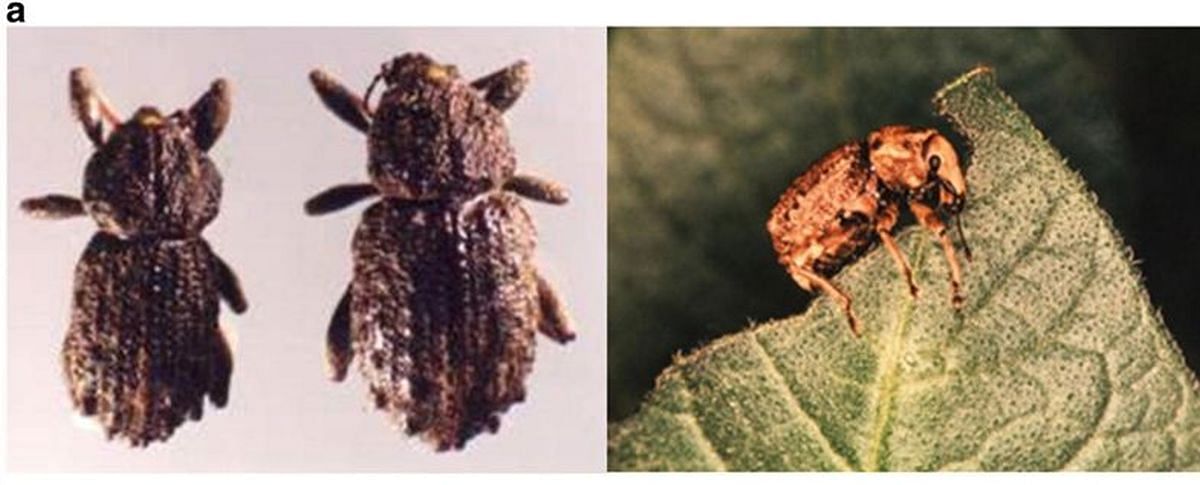Scientific description of the Andean Potato Weevils (2020)
Based on J. Kroschel. et al. (2020) Insect Pests Affecting Potatoes in Tropical, Subtropical, and Temperate Regions. In: Campos H., Ortiz O. (eds) The Potato Crop. Springer, Cham
The authors of this content are Jürgen Kroschel, Norma Mujica, Joshua Okonya, Andrei Alyokhin
Premnotrypes suturicallus Kuschel, P. vorax (Hustache) , P. latithorax (Pierce) (Coleoptera: Curculionidae)
The Andean potato weevil complex consists of at least 14 species with 12 in the genus Premnotrypes and two in the genus Rhigopsidius and Phyrdenus. The most important species attacking potato are Premnotrypes vorax, P. latithorax and P. suturicallus (images below).
All Premnotrypes species show sexual dimorphism; the females (6.8–8.0 mm) are larger than males (5.6–7.5 mm) (Alcázar and Cisneros 1999).

Adult of Premnotrypes suturicallus (a: male, left; female, right), and symptoms of weevil damage on leaves. (Courtesy: CIP)

Symptoms of weevil damage on leaves (b) and of larvae infestation in potato tubers (c). (Courtesy: CIP)
Distribution
The Andean potato weevils (Premnotrypes spp.) are the most serious pests of the potato in the Andean region above 2800 m above sea level. Its distribution extends from Argentina to Venezuela, covering a mountainous territory of about 5000 km in length. These weevils are native to the Andes where wild potato and cultivated species are their hosts (Alcázar and Kroschel 2008).
Host range
The host range of Andean potato weevils includes only potato and its wild relatives.
Symptoms of infestation
The Andean potato weevil, in the larval and adult stages, causes damage to the potato. Adults feed on leaves starting from their edges, marking a very characteristic form of semicircle. When the beetle population is very high, leaves are eaten up to the central leaf vein.
Occasionally, adults can also damage on stolons, tubers during formation, and the stem bases. Serious damage to tubers begins when newly emerged larvae penetrate tubers.
As the larvae develop, they build characteristic tunnels that are usually filled with excreta. Once the larval stage is complete, the larvae leave the tuber making characteristic circular exit holes (Alcázar and Cisneros 1999; Alcázar and Kroschel 2008).
Impacts on production (losses)
Andean potato weevils cause substantial yield losses that seriously threaten Andean farmers’ food security. Losses largely vary (16–45%) even when insecticides are applied. If weevils are not routinely controlled, losses can even reach 80–100% (Ortiz et al. 1996; Kroschel et al. 2012).
Methods of prevention and control
(Alcázar and Cisneros 1999; Alcázar and Kroschel 2008; Kroschel et al. 2012).
- Cultural control.
The main sources of weevil infestations are potato fields of the previous season. It is recommended to maintain community rotation system over distances of about 1 km between fields. Let the field rest for 3–5 years before planting potato and avoid planting potatoes for two consecutive seasons.
Best candidate crops to rotate with include faba bean and barley. Elimination of volunteer potato plants in other crops should be practiced. Early harvest and elimination of crop residues using animals (pigs, sheep) reduces weevil populations in the field. - Mechanical control.
Night collection of adults through plant shaking into buckets. - Physical barriers.
It is a method that prevents the adult weevils from entering the field by using a plastic barrier placed around the potato field. It is recommended to install the barriers before or at the time of planting, to prevent the first adults from entering the new fields.
Results from the use of plastic barriers studies revealed a higher efficacy for the control of the Andean potato weevil than applications of insecticides (Kroschel et al. 2009). - Plant barriers.
Interrupting adult migration into potato fields through plant barriers of tarwi (Lupinus mutabilis Sweet) or mashua (Tropaeolum tuberosum Ruíz and Pavón) has also shown effects of reducing the weevil population. - Chemical control.
Generally, the use of insecticides has not demonstrated a consistent efficacy and farmers still experience losses while spraying insecticides 2–3 times. - Natural enemies.
Although the weevils are native to the Andes, no specific parasitoids have been identified but predators like carabids are wide-spread and affect the weevil population.
Most common species are Blennnidus sp., Notiobia schnusei (Van Endem) and Harpalus turmalinus Er. In addition, entomopathogenic fungi (Beauveria bassiana (Balsamo) Vuillemin) and nematodes (Heterorhabditis sp., and Steinernema sp.) have been identified and used to develop biocontrol strategies (Kroschel et al. 2012; Alcázar and Cisneros 1999; Kaya et al. 2009). - Integrated Pest Management.
An IPM strategy consists of the use of plastic barriers in combination with cultural practices; one insecticide application might be required if plastic barriers are used in potato–potato rotations (Kroschel et al. 2011, 2012).
